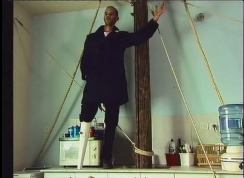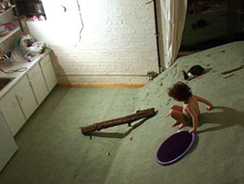Get the Flash Player to see this player.
Excerpt from Guy Ben-Ner’s silent single-channel video Moby Dick, 2000. Courtesy the artist and Postmasters.
Get the Flash Player to see this player.
Excerpt from Guy Ben-Ner’s single-channel video Wild Boy, 2004. Courtesy the artist and Postmasters.

Excerpt from Guy Ben-Ner’s silent single-channel video Moby Dick, 2000. Courtesy the artist and Postmasters.

Excerpt from Guy Ben-Ner’s single-channel video Wild Boy, 2004. Courtesy the artist and Postmasters.
Responses
LOST IN PLAY: ADAPTING THE ZONE OF IMAGINATION IN THE WORK OF GUY BEN-NER
Tom Gunning
Professor, Art History and Committee on Cinema and Media Studies, University of Chicago
Adaptation provides a key to the video work of Guy Ben-Ner, but not simply because some of his key works (such as Moby Dick and Wild Child, both included in the Smart Museum’s Adaptation exhibition) take their titles and imagery from preexisting literary and cinematic works by Herman Melville and François Truffaut. Instead of simply repackaging famous texts in a new form or medium, Ben-Ner deals with adaptation on multiple levels. Most profoundly, Ben-Ner explores the fundamental adaptations that occur as human beings construct their worlds: the creation of a habitus, a home, but also a means of living and dwelling upon the earth. Read more…
ACCOMMODATED, UNACCOMMODATED MAN,
AND DAUGHTER: ADAPTING HOME IN “MOBY-DICK” AND “MOBY DICK”
Jennifer Scappettone
Assistant Professor, English, Creative Writing, and the College, University of Chicago
“Pull, pull, my fine hearts-alive; pull, my children; pull, my little ones . . . . Why don’t you break your backbones, my boys? . . . Three cheers, men—all hearts alive! Easy, easy; don’t be in a hurry—don’t be in a hurry. Why don’t you snap your oars, you rascals? Bite something, you dogs! So, so, so, then;—softly, softly! . . . The devil fetch ye, ye ragamuffin rapscallions; you are all asleep. Snop snoring, ye sleepers, and pull . . . . every mother’s son of ye draw his knife, and pull with the blade between his teeth. That’s it—that’s it. Now ye do something; that looks like it, my steel-bits. Start her—start her, my silver-spoons! Start her, marling-spikes!”
Every mother’s son on the whaleboat is thus summoned “drawlingly and soothingly” by the second mate mid-assault: maternal croons give way to patriarchal reprimands mutating into a succession of fatherly taunts. Such is the candor of domestic affections among the pied Pequod crew. Read more…















